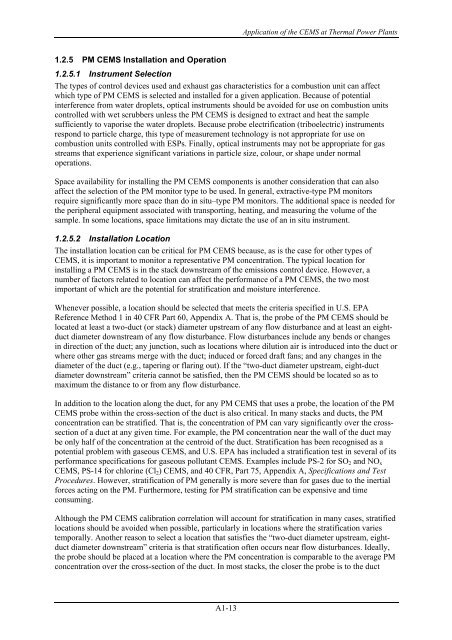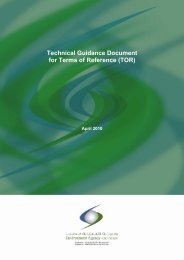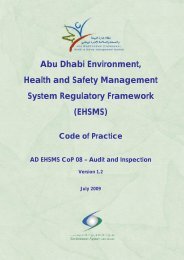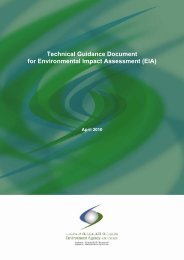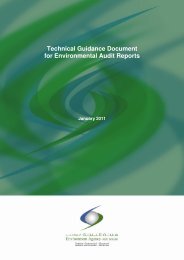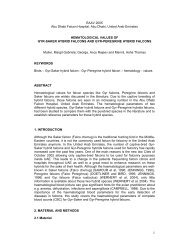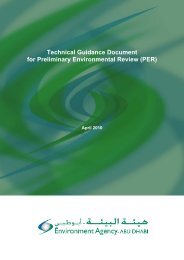Standard Operating Procedure (SOP) for Compliance Monitoring ...
Standard Operating Procedure (SOP) for Compliance Monitoring ...
Standard Operating Procedure (SOP) for Compliance Monitoring ...
You also want an ePaper? Increase the reach of your titles
YUMPU automatically turns print PDFs into web optimized ePapers that Google loves.
Application of the CEMS at Thermal Power Plants<br />
1.2.5 PM CEMS Installation and Operation<br />
1.2.5.1 Instrument Selection<br />
The types of control devices used and exhaust gas characteristics <strong>for</strong> a combustion unit can affect<br />
which type of PM CEMS is selected and installed <strong>for</strong> a given application. Because of potential<br />
interference from water droplets, optical instruments should be avoided <strong>for</strong> use on combustion units<br />
controlled with wet scrubbers unless the PM CEMS is designed to extract and heat the sample<br />
sufficiently to vaporise the water droplets. Because probe electrification (triboelectric) instruments<br />
respond to particle charge, this type of measurement technology is not appropriate <strong>for</strong> use on<br />
combustion units controlled with ESPs. Finally, optical instruments may not be appropriate <strong>for</strong> gas<br />
streams that experience significant variations in particle size, colour, or shape under normal<br />
operations.<br />
Space availability <strong>for</strong> installing the PM CEMS components is another consideration that can also<br />
affect the selection of the PM monitor type to be used. In general, extractive-type PM monitors<br />
require significantly more space than do in situ–type PM monitors. The additional space is needed <strong>for</strong><br />
the peripheral equipment associated with transporting, heating, and measuring the volume of the<br />
sample. In some locations, space limitations may dictate the use of an in situ instrument.<br />
1.2.5.2 Installation Location<br />
The installation location can be critical <strong>for</strong> PM CEMS because, as is the case <strong>for</strong> other types of<br />
CEMS, it is important to monitor a representative PM concentration. The typical location <strong>for</strong><br />
installing a PM CEMS is in the stack downstream of the emissions control device. However, a<br />
number of factors related to location can affect the per<strong>for</strong>mance of a PM CEMS, the two most<br />
important of which are the potential <strong>for</strong> stratification and moisture interference.<br />
Whenever possible, a location should be selected that meets the criteria specified in U.S. EPA<br />
Reference Method 1 in 40 CFR Part 60, Appendix A. That is, the probe of the PM CEMS should be<br />
located at least a two-duct (or stack) diameter upstream of any flow disturbance and at least an eightduct<br />
diameter downstream of any flow disturbance. Flow disturbances include any bends or changes<br />
in direction of the duct; any junction, such as locations where dilution air is introduced into the duct or<br />
where other gas streams merge with the duct; induced or <strong>for</strong>ced draft fans; and any changes in the<br />
diameter of the duct (e.g., tapering or flaring out). If the “two-duct diameter upstream, eight-duct<br />
diameter downstream” criteria cannot be satisfied, then the PM CEMS should be located so as to<br />
maximum the distance to or from any flow disturbance.<br />
In addition to the location along the duct, <strong>for</strong> any PM CEMS that uses a probe, the location of the PM<br />
CEMS probe within the cross-section of the duct is also critical. In many stacks and ducts, the PM<br />
concentration can be stratified. That is, the concentration of PM can vary significantly over the crosssection<br />
of a duct at any given time. For example, the PM concentration near the wall of the duct may<br />
be only half of the concentration at the centroid of the duct. Stratification has been recognised as a<br />
potential problem with gaseous CEMS, and U.S. EPA has included a stratification test in several of its<br />
per<strong>for</strong>mance specifications <strong>for</strong> gaseous pollutant CEMS. Examples include PS-2 <strong>for</strong> SO 2 and NO x<br />
CEMS, PS-14 <strong>for</strong> chlorine (Cl 2 ) CEMS, and 40 CFR, Part 75, Appendix A, Specifications and Test<br />
<strong>Procedure</strong>s. However, stratification of PM generally is more severe than <strong>for</strong> gases due to the inertial<br />
<strong>for</strong>ces acting on the PM. Furthermore, testing <strong>for</strong> PM stratification can be expensive and time<br />
consuming.<br />
Although the PM CEMS calibration correlation will account <strong>for</strong> stratification in many cases, stratified<br />
locations should be avoided when possible, particularly in locations where the stratification varies<br />
temporally. Another reason to select a location that satisfies the “two-duct diameter upstream, eightduct<br />
diameter downstream” criteria is that stratification often occurs near flow disturbances. Ideally,<br />
the probe should be placed at a location where the PM concentration is comparable to the average PM<br />
concentration over the cross-section of the duct. In most stacks, the closer the probe is to the duct<br />
A1-13


